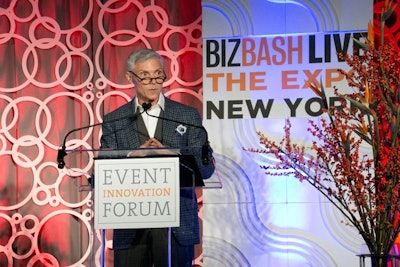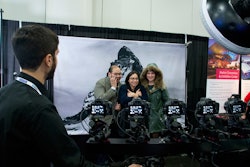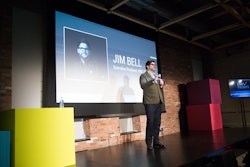
The creative minds from Google, Essence, iHeartMedia and more shared how they work with sponsors, use social media, and reinvent their events during the Event Innovation Forum at BizBash Live: The Expo New York on Tuesday at the Jacob K. Javits Convention Center. Here are their top tips.
1. Don't oversell to attendees.
At Samsung 837, a high-tech showroom and cultural hub, events do not blatantly market to people but rather create immersive experiences. Zack Overton, vice president and general manager of the space, calls these "un-events," and the venue has hosted 365 events its first nine months since opening in February. The idea is to drive brand loyalty with an event strategy anchored in cultural pillars such as art, music, sports, entertainment, fashion, technology, culinary, and wellness. "By removing retail from the equation, it really changes how people engage with our staff and our products," he said.
For New York Fashion Week, Samsung 837 partnered with the Council of Fashion Designers of America to reimagine a Fashion Week experience. "On the one hand, we were helping designers and brands reach a wider audience and created a deeper engagement," Overton said. "On the other hand, we wanted to democratize the week of events that are typically reserved for [industry insiders]."
Samsung came up with the concept of having an "Un-Fashion Week" to "take people beyond the velvet rope and give them unprecedented access, whether it was through attending events at Samsung 837 or through live streaming or virtual reality."
2. Create "FOMO" urgency on social media.
Strategically using Facebook, Snapchat, and Instagram before, during, and after events is essential to engage attendees, according to Candace Montgomery, senior director of event marketing at Essence Communications. The typical Essence audience member has high social engagement, so Essence encourages them to create "in the moment" social-media activities as well as rewards them with content like Facebook Live access to talent. These activities create a "fear of missing out," which then can lead to future ticket sales or additional online engagement.
Montgomery said the idea is to "create a rich experience that is so exciting and so big that people cannot help themselves but to share about it socially." The strategies work. This year's Essence events yielded a high number of impressions on social media, according to Montgomery: 1.2 billion impressions for Black Women in Hollywood, 9.4 billion impressions for the Essence Festival, and 206 million impressions for Essence Street Style.
3. Overcome obstacles with creative ideas.
"There is a world of difference between being spectacular and spectacle," said David Monn, C.E.O. of event company David Monn. Talking about rites, rituals, and protocols, he cautioned against spectacle and suggested instead to focus on four ideals: being (who we are), belonging (connection to others), belief (what is our purpose), and beauty (seeking order and harmony).
Monn—who has designed events such as a state dinner at the White House and high-profile charity galas—said event designers confront obstacles with creative solutions. At one wedding venue, an inconveniently placed column became a cherry tree in a nod to the bride's favorite tree. Monn said of his philosophy on planning events: "Authenticity, scale, and details are the three rules I believe in."
4. Create an experience that inspires loyalty and repeat business.
JF Bouchard, the C.E.O. and co-founder of Sid Lee and C2 Montréal, emphasized that every event is a story. And, like any good story, it needs narrative art that has the ability to surprise people and evolve. "Status quo is riskier than change," Bouchard said. Brands should emulate the entertainment industry and ask questions such as: "Why would people pay to experience this? Can this event platform generate fans? Can it become a franchise?"
An example Bouchard gave was Stella Artois's multi-sensory dining experiences, which have recently become a staple for the beer brand. "Brands should be producers, not just sponsors," said Bouchard. "Brands should do things, not just say things."
5. Have synergy in cross-promotional opportunities.
As a company that produces more than 20,000 live music events a year that target audiences of various music tastes and ages, iHeartMedia has multiple platforms to offer sponsors. "Own, operate, produce, execute, recap, and repeat," said Natasha Eno, iHeartMedia's vice president of events and venue partnerships, citing the company's business model. "The most impactful partnerships form when you combine everything together," she said, noting that brands can make the mistake of separating assets including media budgets and experiential budgets.
For live events, Eno explained that it's important to have a clear idea of the event strategy and how the events are going to communicate with people. The company promotes its events—including the iHeartRadio Music Festival, the Heart Radio Music Awards, the iHeartRadio Jingle Ball franchise, and the iHeartCountry Festival—to its audiences on various platforms, including social, radio, and digital. "For four to 10 weeks before the actual event, we're talking about it on our radio stations," said Eno. "If you're hosting an event and no one knows about it, you're only resonating with those 20,000 people attending. But if you have scale, scope, distributions, and partnerships, you're reaching 20 to 30 million people with your brand message."
6. Use emotion to create memorable experiences.
After experiencing the Burning Man festival in the Nevada desert, Michael Blatter, founder and C.E.O. of the experiential agency Mirrorball, wondered if there was a science behind throwing an event that creates an emotional impact. His team learned that experience and emotion form a foundation for memory, and the main link between experience and memory is narrative. They use that insight to create unforgettable experiences at events beyond typical photo-and-social sharing opportunities.
An example is a project for Jack Daniel's, which recently recreated its origin town of Lynchburg, Virginia, with an immersive pop-up store in Manhattan. Blatter also noted that experiences don't necessarily have to have multiple extreme elements. "An emotional roller coaster isn't always necessary," he said. "Sometimes a singular moment can elicit emotions."
7. Keep annual events fresh through reinvention.
Google I/O, the company's annual developer conference in the San Francisco Bay area, has reinvented itself since its inaugural edition in 2008, including a major revamp for the 2016 event in May. "Annual events face a lot of pressure to stay fresh," said Amanda Matuk, the conference's executive producer. "The most meaningful change is change that impacts the process or the business outcome."
This year, the conference moved from the Moscone Center in San Francisco to Shoreline Amphitheatre in Mountain View (the city where Google is headquartered), and hosted its first festival village for the conference's more than 7,000 attendees. A driving idea was weaving Google's personality into the event. "Great just isn't good enough," Matuk said. "We brought the magic and fun of our company culture to the I/O experience this year. We let our personality really shine and stayed true to ourselves throughout."



















